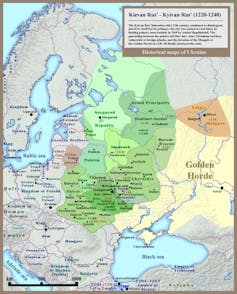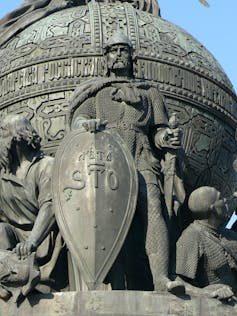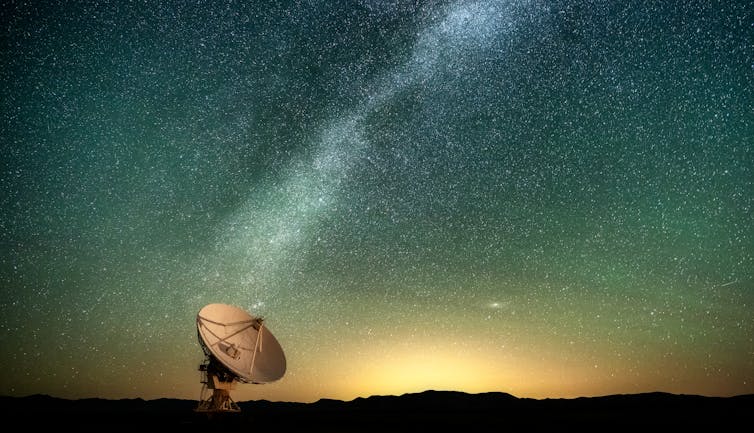Vladimir Putin’s history war where truth is the first casualty
Putin began this two-hour interview with a lengthy monologue about the medieval history of Russia and Ukraine

Estimated reading time: 12 minutes
Nick Mayhew, University of Glasgow
The Kremlin’s decision to sanction several UK historians for their allegedly erroneous coverage of Russian history shows the extent to which Vladimir Putin’s regime is doubling down on its view of Ukraine as historically Russian. Putin’s suggestion is so spurious that it requires the silencing of credible historians.
The world got another taste of Putin’s view of history on February 6, when the Russian leader was interviewed by former Fox News host Tucker Carlson. The thrust of his argument is that much of modern Ukraine is historically Russian, and that the very idea of Ukraine is nothing more than a Polish invention.
As Putin tells it, in the year 862 the people of the city of Novgorod invited a Viking called Rurik to reign over them. Two decades later, Rurik’s successor, Oleg, established himself in the southern city of Kyiv. Thus, in Putin’s view, Russia was formed in the ninth century, and it incorporated territories stretching from Novgorod, a northerly city in modern-day Russia, to Kyiv, the capital of modern-day Ukraine.
Already, alarm bells ring for any historian familiar with the context. First of all, Putin’s story is exactly that, a story. His account of Rurik and Oleg comes from a 12th-century text known as the Primary Chronicle. Written by a monk in Kyiv, it celebrated the ruling Rurik dynasty through a series of myths. The Primary Chronicle is as much a work of fiction as a history. It begins with a legend tracing the origins of the Slavic people all the way back to Noah’s Ark.
As far as Putin’s narrative about Rurik goes, modern scholars interpret the people behind Novgorod’s “invitation” as a literary invention. Some have even suggested that Rurik may have been entirely made up. Putin reeled off this unlikely story from a mythological and deeply biased work of 12th-century literature as historical fact.
More concerning still is Putin’s reference to the existence of Russia in the ninth century. At that time, a kingdom of sorts was emerging that historians often call Kyivan Rus. Kyivan Rus comprised principalities spanning part of what is now modern-day Belarus, Russia and Ukraine. Those principalities were ruled over by different branches of the Rurik dynasty, who often fought with one another. The most senior member of the dynasty resided in Kyiv, the kingdom’s religious centre.

Kyivan Rus was not “Russian”, as Putin has called it. Kyivan Rus predates Russia, which began to form around Moscow only from the 14th century. The language of Kyivan Rus was Old East Slavic (OES), the language from which modern-day Belarusian, Russian and Ukrainian derive.
Medieval texts in OES referred to Kyivan Rus as “the Rus land”. Conveniently for the Kremlin, OES words describing Kyivan Rus are often similar to Russian words describing Russia. For example, in OES “the Rus land” is “ruskaya zemlya”, while in Russian the strikingly similar “russkaya zemlya” means “the Russian land”.
Lexical similarities between OES and Russian allow Putin to present Kyivan Rus as Russia – failing to note that OES and Russian are different languages.
Blame it on Poland
Putin then skipped forward a few centuries, suggesting to Carlson that the idea of Ukraine was really invented by the Poles. From the late 16th century, part of what had been Kyivan Rus was incorporated into the Polish-Lithuanian Commonwealth. Although this area would later become Ukraine, Putin implies that it was actually Russian, and that the Poles invented the idea that it was Ukrainian as a way of undermining Russia.

Presenting “Ukrainianness” as a Polish invention overlooks the development of a unique culture that was underway in this area in the 1600s. This culture was unique in its innovation of conservative religious tradition and development of new cultural forms.
For example, in 1646 the Kyivan church leader Petro Mohyla published a new church book that did away with certain traditions that had been practised in the region since the 11th century, such as spiritual brotherhood ceremonies. His book also presented western-inspired images that stood in stark contrast to Russia’s Byzantine-style icons, introducing new and provocative ways of envisioning Christ.
Putin painted a picture of this area as fundamentally Russian and its people as passive, shaped by their imperial overlord Poland. In reality, the culture developing there was distinct. Like Russia, it drew on cultural models from Kyivan Rus, but in contrast to Russia, it innovated those models through cultural exchange with Europe. This was thanks to the active efforts of cultural innovators, some of whom are major figures in Ukrainian history.
Putin’s claim that Ukraine is historically Russian is nothing new. Ever since Russia began forming around Moscow from the 14th century, it saw itself as a continuation of Kyivan Rus. That mindset prevailed when modern Russian history was first written in the 19th century. Karamzin’s 1829 History of the Russian State, still one of Russia’s most celebrated history books, called Kyivan Rus “Russia”.
So, Putin’s early history of Ukraine is part of a Russian imperialist story that has been told for centuries. Only it is exactly that, a story.![]()
Nick Mayhew, Lecturer in Russian, University of Glasgow
This article is republished from The Conversation under a Creative Commons license. Read the original article.
What's Your Reaction?
























